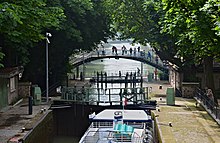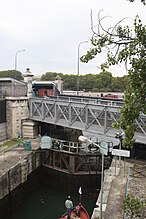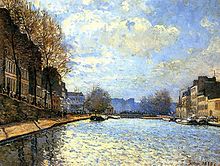Canal Saint-Martin
The Canal Saint-Martin is a shipping canal in the east of Paris . Opened in 1825, it connects the Bassin de la Villette with the Seine at Port de l'Arsenal in a north-south direction and runs in a tunnel for almost half of its 4.5 kilometers.
history
Napoleon Bonaparte issued a decree on May 19, 1802 that a shipping canal ( canal de navigation ) should be built between the Bastion de l'Arsenal and the Bassin de la Villette .
"Il sera ouvert and canal de navigation qui partira de la Seine au-lingerie du bastion de l'Arsenal, se rendra dans les bassins de partage de la Villette [...]"
At the same time, the construction of an adjoining shipping canal, the Canal Saint-Denis and the Canal de l'Ourcq , which would bring the water from the river Ourcq , which rises almost one hundred kilometers northeast of Paris , was planned. The major project was necessary, firstly, to ensure the drinking water supply and to get clean water for wells as well as the street and sewer cleaning, and secondly to expand the traffic and trade routes.
Napoleon entrusted the architect Pierre-Simon Girard with the planning on September 15, 1802. Since the planned Canal Saint-Martin ran through an already urbanized area, numerous plots of land had to be bought from the owners and buildings demolished, which significantly delayed construction work. The wars during the First Empire also prevented a quick start of construction. Girard was not able to begin his first work until 1813, on the canal tunnel under the Place de la Bastille , but soon had to abandon it. In order to have the canal construction financed privately, the city of Paris founded the Compagnie des canaux de Paris in April 1818 as a licensor.
The bankers Vassal and Hainguerlot were awarded a lease of 5.47 million francs in November 1821 and became licensees for 99 years. In the summer of 1822, work could be resumed and after three years of construction, the last section in 1825 was the Place de la Bastille in a 180 meter long gallery. On November 4, 1825, Charles X opened the Canal Saint-Martin . Together with the Canal Saint-Denis , it was initially called Canal de la Seine à la Seine ("Canal from the Seine to the Seine") and cost 24 million francs.
For the construction of a crossing boulevard (today Boulevard Voltaire ) in the Second Empire , the Prefect of Paris Georges-Eugène Haussmann had the canal between the Place de la Bastille and the Avenue de la République laid underground over a length of one and a half kilometers ( voûte souterraine ), which was regulated by decree of April 30, 1859. The engineer Eugène Belgrand moved the lock at the Bastille to the north on rue Faubourg du Temple . Larger and more stable bridges could now be built over the five-meter-lowered canal. There was also space on the tunnel cover for the sixty-meter-wide Richard-Lenoir boulevard .
Under the Place de la Bastille , 1860
South of the Rond-Point de la Villette , the right washing vessels , about 1906
In 1906 the tunnel was extended by a further 245 meters to the north and the demolition of the docks there was approved by decree. The Boulevard Jules-Ferry has been running here ever since . In 1963 it was planned to build a motorway over the canal that would connect Le Bourget and Orly airports . The expected traffic volume of six thousand vehicles per hour in both directions, however, led to protests from local residents. The project ended on December 15, 1971. Excursion ships operated by a private shipping company have been permitted on the canal since 1983. In 1990 the canal received the status of a Monument Historique .
The canal is drained at irregular intervals in order to clean the bottom of the canal. This happened around the years 2002 and the beginning of 2016. In 2002, over 40 tons of waste were recovered from the canal as part of the drainage process.
Location and importance
The Canal Saint-Martin runs in a north-south direction through the 10th and 11th arrondissement as well as a short distance at the beginning and end through the 19th and 12th arrondissement. In the past it was mainly used by barges ( péniches ). Since 1862, ship transport has been operated by chain shipping over a length of 2650 meters (1850 meters of which in the tunnel) . Several barges were pulled by a chain tug boat along a chain laid lengthways in the canal. The shipping traffic on this section of the canal was very important. The chain tractor had an output of 15 kW (20 hp) and reached a speed of 2 kilometers per hour in towing mode. Since the renovations in 1999 and 2002, the canal has mainly been used by excursion boats and private boats. It forms part of the 130 km long Parisian canal network Réseau des Canaux Parisienne . Its waterfront promenades have become a popular resort. On Sundays and public holidays, the quayside streets in the 10th arrondissement are closed to through traffic.
Southern tunnel entrance below the Bastille metro station
Écluse de l'Arsenal lock at the confluence with the Seine under the Pont-métro Morland metro bridge
Technical specifications
The toll canal is 4,554 m long, 27 m wide (in the underground parts 16–24 m) and contains five locks ( écluses ) - four of which are double locks - and two swing bridges ( ponts tournants ) named Dieu and Grange-aux- Belles . They were built in 1885 and replaced previous wooden structures. The canal overcomes a height difference of 24.5 meters with an average water depth of 2.32 m. The underground part of the canal lies in an 8 m wide semicircular tunnel ; the height of the tunnel arch above the water level is 5.25 meters. The tunnel is now 2,190 m long.
Coordinates
- Starting point of the canal: 48 ° 53 '2 " N , 2 ° 22' 16" E
- End point of the canal: 48 ° 50 ′ 50 ″ N , 2 ° 21 ′ 59 ″ E
Further information
- At the northern entrance to the canal is the classicist Rotonde de la Villette from 1788 by the architect Claude-Nicolas Ledoux .
- On the Canal Saint-Martin there are several industrial buildings from the 19th century, including a branch of the Exacompta / Clairefontaine group on quai de Jemmapes . The factory is located in a monument historique and is one of the last factories in Paris.
- The Hôtel du Nord , built in 1885 on quai de Jemmapes No. 102, was the location for the film Hôtel du Nord made by Marcel Carné (premiere in France: December 17, 1938), which worships the atmosphere of this canal landscape in the middle of the city. It was through him that the career of the Parisian actress Arletty began . Today the hotel only functions as a bar and restaurant. The film The fabulous world of Amélie (German premiere: August 16, 2001) is also set in the area around the canal.
- The Canal Saint-Martin is the setting for a number of novels, including a. with Léo Malet and Georges Simenon . Jacques Tardi drew it.
- In the winter of 2006/2007, the canal was the scene of a well-known campaign by the Les Enfants de Don Quichotte initiative to help the homeless. Around 200 red tents were erected on the bank to demonstrate for a universal right to housing .
- In the winter of 2015/16, the sewer water was drained for cleaning and repair work, which caused a muddy garbage dump to come to the surface. The work lasted four months.
Alfred Sisley : View of the Canal Saint-Martin , 1870
literature
- Marie Babey: Je me souviens du Canal Saint-Martin. Editions Parigramme, Paris 2006, ISBN 2-84096-063-X .
- Chris Boicos et al. a .: Paris. RV Reise- und Verkehrsverlag, Berlin 1994, ISBN 3-89480-901-9 , pp. 260-261.
- Pierre Pinon: Patrimoine fluvial. Canaux et rivières navigables. Nouvelles Éditions Scala, Paris 2009, ISBN 978-2-35988-006-9 .
Web links
- lartnouveau.com - Private site with current and historical photos.
- Canal Saint-Martin. In: Structurae
- Canal trip. In: Die Zeit , September 2, 1983
Individual evidence
- ↑ a b N ° 1551. Bulletin des lois, n ° 193 et 194. Lois relatives aux Canaux et à la Navigation. You 29 Floréal to X de la République Française. Imprimerie du Dépôt des Lois, Paris 1802, p. 4, cover of N ° 1551. Bulletin des lois ... ( Memento from November 15, 2013 in the web archive archive.today ) and online text document.
- ↑ Pierre Simon Girard: Description générale des différens ouvrages à exécuter pour la distribution des eaux du Canal de l'Ourcq dans l'intérieur de Paris (...). Imprimerie Impérial, Paris 1812, ( online , accessed November 15, 2013)
- ^ Gotthilf Hagen: Description of recent hydraulic structures in Germany, France, the Netherlands and Switzerland. Bornträger, Königsberg 1826, p. 165, digitized version of the Bavarian State Library .
- ↑ Bulletin des lois de la République Française , Volume 7, 1825, p. 113
- ^ Simon Lacordaire: Histoire secrète du Paris soutterain. ( Memento of October 18, 2014 in the Internet Archive ). Hachette, Paris 1982, ISBN 978-2010085789 .
- ^ Gotthilf Hagen: Description of recent hydraulic structures in Germany, France, the Netherlands and Switzerland. Bornträger, Königsberg 1826, p. 164 ff.
- ↑ Jean Baptiste J. Champagnac: Manuel des dates en forme de dictionnaire. 1839, p. 238, in Google Books .
- ↑ Video: Croisière canal St Martin. In: Canauxrama , 5:53 min., Accessed September 19, 2016.
- ↑ Johannes Freybler: The great love rests at the bottom of the canal. In: FAZ , August 7, 2014, page R5.
- ↑ Canal Saint-Martin in the Base Mérimée of the French Ministry of Culture (French)
- ^ Rudolf Balmer: Great cleaning in the Canal Saint-Martin: What lies on the bottom of a Paris canal. In: Neue Zürcher Zeitung , January 11, 2016, with photo gallery.
- ↑ A. Schromm: The various methods of moving ships on canals and canalized rivers , In: Journal of the Austrian Association of Engineers and Architects, Volume 42, Issue 3, 1890, pages 75-79 ( online (PDF file; 9 , 5 MB))
- ↑ Oskar Teubert: The inland navigation - A manual for everyone involved. Volume 2, Verlag Wilhelm Engelmann, Leipzig 1918, Part 4, Section III., Ship Train. 4. Dragging on a chain or rope, pp. 268–287.
- ^ Un bon plan à Paris. Canal Saint-Martin. ( Memento from June 10, 2015 in the Internet Archive ). In: City of Paris , 2007, times when cars were closed on the embankment (PDF; 76 kB).
- ^ Mairie de Paris, Direction de la protection de l'environnement: Rallye de l'eau. Paris 2007, p. 13.
- ^ Joseph Hanimann : Homeless Action. Tent city in the middle of Paris. In: FAZ , January 9, 2007.
- ↑ Katja Mollenhauer: The tent ends of Paris. ( Memento from June 3, 2012 in the Internet Archive ). In: Street sweeper , April 7, 2007.
- ↑ Photo gallery: When a Paris canal is drained. ( Memento from April 16, 2018 in the Internet Archive ). In: Los Angeles Times , January 6, 2016, (English).









